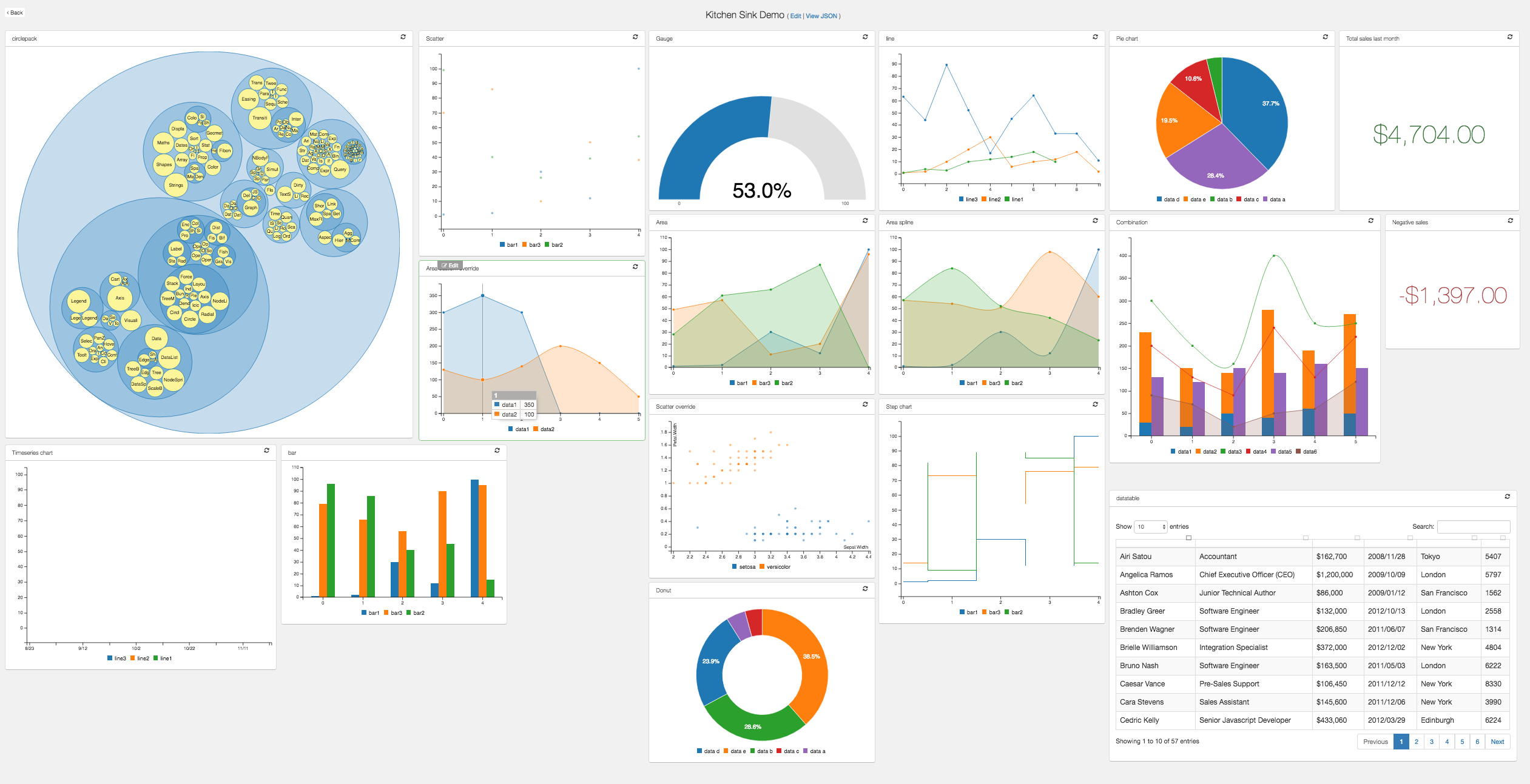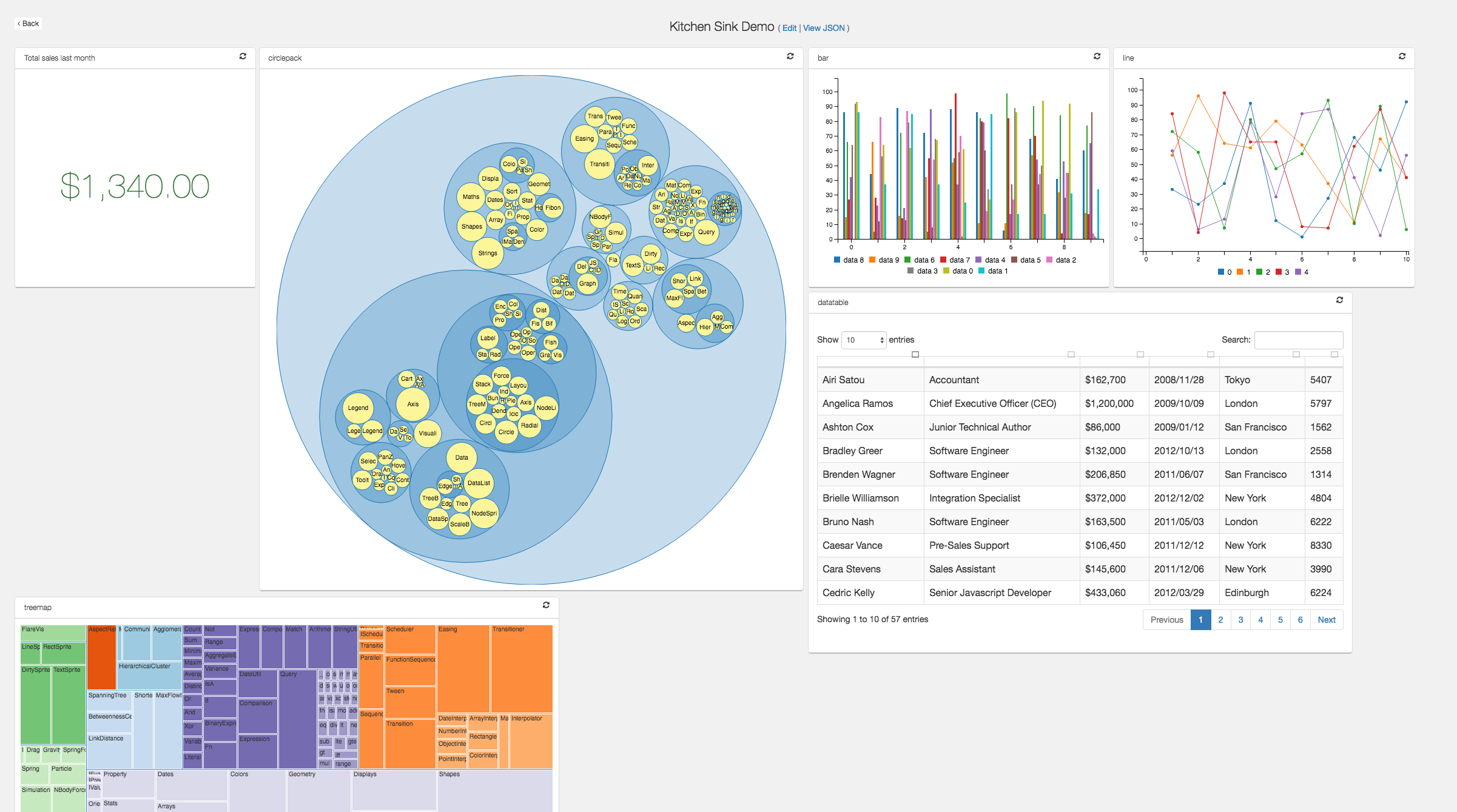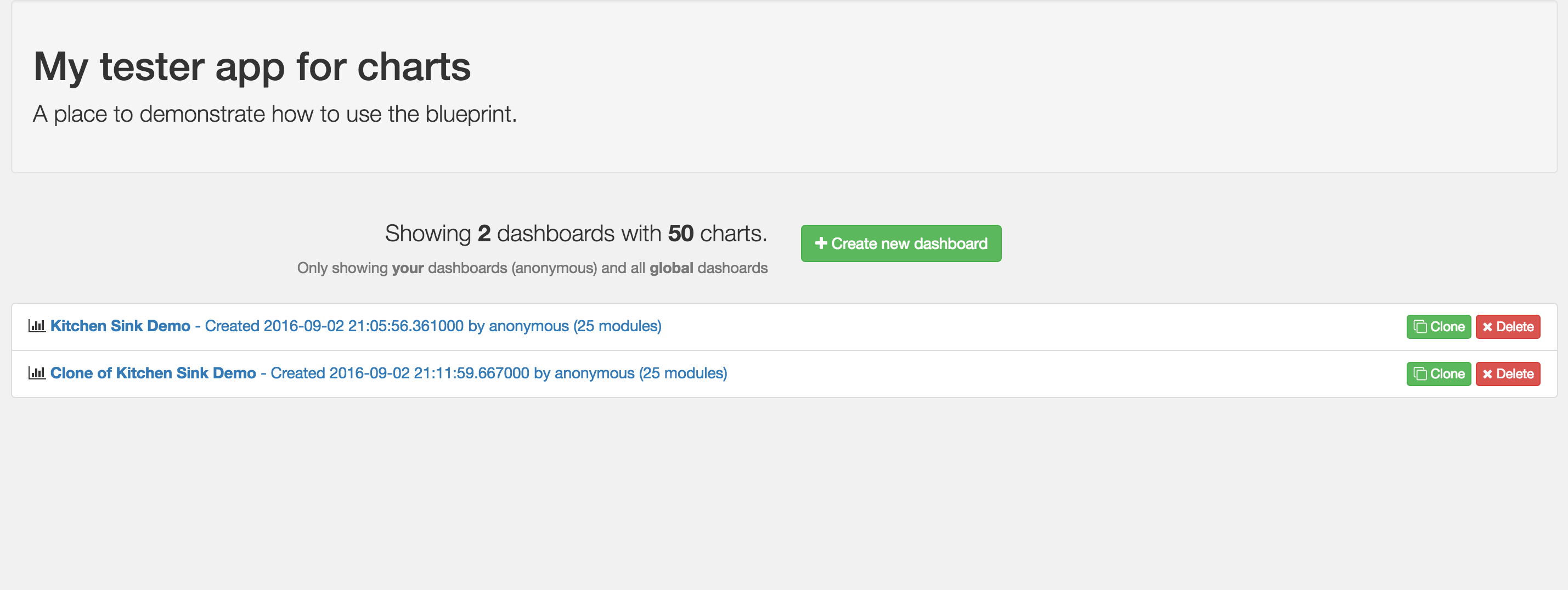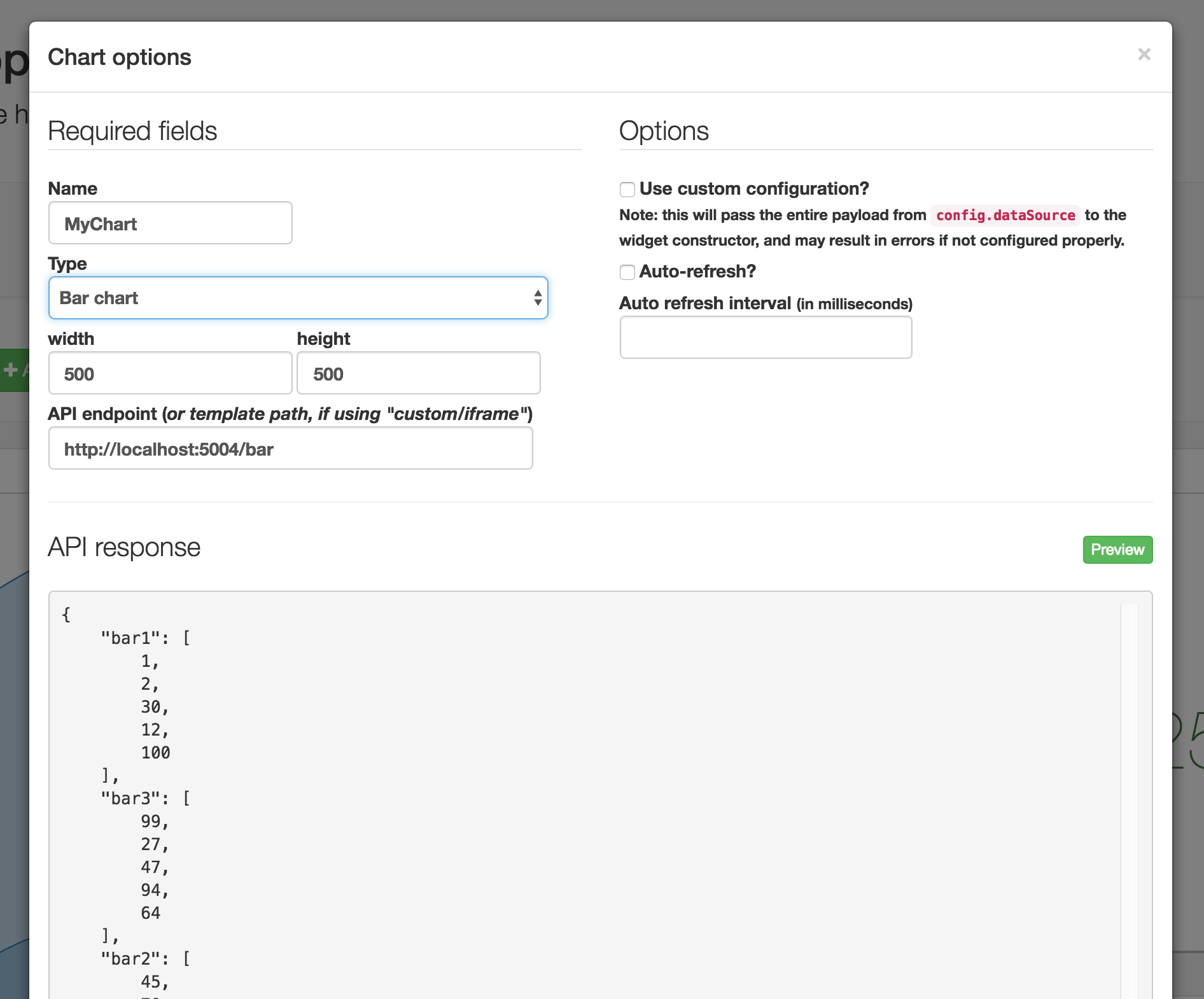Easily configurable, chart dashboards from any arbitrary API endpoint. JSON config only. Ready to go.
This project is a flask blueprint that allows you to create sleek dashboards without writing any front end code. It saves JSON configurations for declaring arbitrary charts, leveraging popular libraries like C3.js and D3.js.
It also supports templates and iframes, as well as other data visualization libraries. The beauty of this approach is that only a basic configuration is required. It uses any specified json endpoint to get data from, so long as the payload format is correct.
The dashboard layout and blueprint styles are pre-packaged, and provide only the essentials, while getting out of the way.
The configuration JSON provides core functionality and is at the heart of the project. There are several comprehensive examples available in the examples/config directory to give you an idea of how it works, as well as the core configuration documentation. An simple example:
{
"modules": [
{
"type": "timeseries",
"name": "name3",
"width": 510,
"height": 400,
"dataSource": "http://localhost:5001/test1"
}
]
}(4.0 and later) You can even provide custom inputs to allow interactivity on each chart!
E.g.
{
"modules": [
{
"name": "line",
"height": "400",
"width": "500",
"dataSource": "http://127.0.0.1:5004/custom-inputs",
"override": false,
"guid": "a6eb10e7-26fa-7814-818a-3699b24415c5",
"type": "line",
"inputs": {
"btn_classes": ["btn", "btn-info", "btn-sm"],
"submit_text": "Submit",
"options": [
{
"type": "number",
"name": "entries",
"input_classes": ["form-control", "input-sm"],
"label": "Number of points",
"help_text": "Change the number of points per entry shown"
}
]
}
}
]
}Which will map to query parameters (entries=10 in this example) that you can use to filter or change what your endpoint returns!
Also note that the order of the inputs in the json will determine their order in html.
See the examples/config directory for all the supported options.
If you want to see all/most charts in action, you'll need to fire up the endpoints.py flask app (included) alongside your main app that uses the blueprint, create a new dashboard, then choose the edit raw json option, specifying one of the json files found in examples/config. (This has been tested using mongodb).
Each chart is very straightforward. Most of the power is leveraged by the various charting libraries that flask-jsondash defers to. See schemas for more detail on how your endpoint json data should be formatted for a given chart type, as well as how to find docs for each supported library.
Method 1 - use provided flask app
git clone https://github.com/christabor/flask_jsondash.git
cd flask_jsondash
virtualenv env
source env/bin/activate
python setup.py install
python app.pyThis will setup the app in a virtual environment and run the included test app (app.py) immediately on port 5002.
If you want to import the blueprint into your own existing flask instance:
Method 2 - use your existing app
pip install flask-jsondashYour app will need to import and register the blueprint, as well as have the appropriate template tags. An example of this can be found here.
- Flask
- Jinja2
These are not included, as you are likely going to have them yourself. If you don't, you'll need to add them:
- Jquery (JS)
- Bootstrap (CSS/JS)
These are necessary and included, based simply on the likelihood they may not already be used:
- JRespond (JS)
- Masonry (JS)
- Jquery UI (CSS/JS)
Chart requirements depend on what you want to expose to your users. You can configure these in the CHARTS_CONFIG dictionary in the settings.py file. You can override these settings by adding your own file, called settings_override.py
Make sure the following env vars are set:
CHARTS_DB_HOST- The DB server hostname (defaults to 'localhost')CHARTS_DB_PORT- The DB server port (defaults to 27017)CHARTS_DB_NAME- The DB database name (defaults to 'charts')CHARTS_DB_TABLEThe DB collection name (or sql table name) (defaults to 'views')CHARTS_ACTIVE_DBThe DB backend to use - options: 'mongo', 'postgres' (defaults to 'mongo')
Make sure to start so json configuration can be saved.
Start however you'd like, but usually mongod will work. Note: you will need to make sure the collection has been created within your mongo instance, and is specified in the CHARTS_DB_TABLE env var, as well as specify your database name under the CHARTS_DB_NAME env var
Start however you'd like, but usually postgres -D /path/to/data/ will work.
Either import and use the blueprint in your own flask app, or run app.py directly to start the app as-is.
Run endpoints.py if you'd like to test out existing endpoints to link your chart json to.
See endpoints.py for examples on how to achieve this. If you do not allow CORS on the server-side, all ajax requests will fail.
By default, no authentication is performed for a given action. However, supporting your own custom auth for each type is just a simple config away. Using the flask pattern of injecting configurations into the app.config namespace (in this case, JSONDASH must be specified), you can put whichever functions you want, and only those specified will be checked. Here is a working example:
def can_delete_charts():
return session.get('user')['name'] in SECRET_ADMINS
charts_config = dict(
auth=dict(
delete=can_delete_charts,
),
)
app.config['JSONDASH'] = charts_configSee below for the supported types and their details.
edit_global
This determines if a user can create OR update a chart with the "global" flag set, which will show the dashboard to all users if the appropriate application flags are set (see global config flags below) If no flag is set for allowing global dashboards, then this option will not be available.
delete
Allows deleting of charts.
clone
Allows cloning of charts.
update
Allows updating of charts.
create
Allows creation of new charts.
view
Allows viewing of a chart. The provided function will be passed the id of the view.
Metadata can be added to the json configuration for further customization purposes. All arbitrary values will expect an accompanying function to be populated with, in the exact same way as the auth functions listed above. They will all be namespaced under the metadata key inside of the app.config['JSONDASH'] dictionary, if specified.
Below is an example of how you can override these fields with your own arbitrary functions. Note: by default, none take arguments. This may change for specific types.
charts_config = dict(
metadata=dict(
created_by=get_username,
),
)
app.config['JSONDASH'] = charts_configThe following metadata overrides are used, but you can also add arbitrary keys and values, which will be saved to the dashboard config, just not necessarily used here.
created_by
This is used to organize views on the front-page by user, if there is such a key present on the configuration. This key is updated and saved if present, null otherwise.
user
This is the current logged in user. This is required for filtering dashboards by user. You must also set the JSONDASH_FILTERUSERS flag to True in app.config.
Below are global app config flags. Their default values are represented in the example working Python code.
app.config['JSONDASH_FILTERUSERS'] = False: for filtering dashboards by the logged in user. See above for setting user data.
app.config['JSONDASH_GLOBALDASH'] = True: for allowing "global" dashboards to be shown. These dashboards must have a created_user of "global" or be overridden (see below).
app.config['JSONDASH_GLOBAL_USER'] = "global": An owner name to use when allowing global dashboards to be seen. This is set on the created_by property in the specific json config. See above for more examples.
app.config['JSONDASH_MAX_PERPAGE'] = 50: The number of results to show per page. Remaining results will be paginated.
By default, all assets (css/js) will be loaded remotely by popular CDNs recommended for the given charting library.
However, you might want to ensure assets are always available, or cannot access them because of network/proxy issues. If you would like to use your own local assets specified inside of the settings.py file, you can download them, put them in your app somewhere, and then tell jsondash where they should be loaded from (using the standard flask url_for('static', filename=XXX) pattern.)
Just add a static key in your JSONDASH config with these values like so:
app.config['JSONDASH'] = dict(
static=dict(
js_path='js/vendor',
css_path='css/vendor',
)
)With default flask static settings, this would resolve the url to /static/js/vendor/filename.js for example.
You can use one or the other, but it's recommended to use both or none.
This project uses semantic versioning for releases. However, the master branch is considered to be unstable as it represents "bleeding edge" with updates, hotfixes, etc... that eventually get tagged with a release. If you want to use a stable version, make sure to pin the specific release you want to target.
Q: "Why'd you choose to expose library X, Y, or Z?"
A: I tried to go for libraries that are pretty widely known and popular. If you are dissatisfied with what's exposed, you can always add your own by embedding any js/css and html in a template, and loading it through the iframe option.
Q: "How do I customize X, Y, Z?"
A: Because of the level of abstraction used here, a lot of charts will naturally be less configurable than if they had been scripted by hand. This is the tradeoff with being able to quickly setup a lot of charts easily.
The goal here is to use intelligent defaults as much as possible, and then allow the most universal aspects to be customized through a common interface.
However, you can inject raw json-friendly configurations if your chart has the override flag set. This will not work for all charts. See configuration options for more.
Keep in mind, many stylistic customizations can be overridden in css, since most all charts are html and/or SVG. And, as mentioned above, you can always use override option, or the iframe/custom option and make your dataSource endpoint return whatever you want, including a full html/js/css pre-rendered template.
Q: "When exposing metadata, why don't you just use the g variable and read from that?"
A: One way this can be done is using the @app.before_request decorator, and populating the g variable with metadata. The problem is that it creates extremely unnecessary overhead.
Because the chart builder utilizes simple endpoints, you can use the power of REST to create more complicated views. For example:
curl -XGET http://localhost:5002/api/foo/
could return {"data": [1, 2, 3, 4]}, but you could customize the url by updating the url saved in your dashboard to support query arguments:
curl -XGET http://localhost:5002/api/foo?gt=9
could return {"data": [10, 20, 30, 40]} instead!
While the data is not dynamically generated, you can easily use Github gists (or any raw file from github.com for that matter) to load charts! Check out the kitchensink dashboard to see a real working chart loaded from via gist!
Performance metrics are not available, but you can view some "stress test" examples for the example endpoints. The configuration for these are available in examples/config/stresstest.json. Also, the comprehensive examples (plotly, kitchensink) above are very complex dashboards (20-30 charts, webgl, etc), and have been tested in the browser.
A couple observations on stress tests (performed on Macbook Pro / 16gb / 2.7ghz i7):
- Native D3.js handles large datasets very well. It handled 1-2mb json files with no problem.
- Datatables handles extremely large datasets with no problem. Maximum tested before degradation was around 100,000 rows.
- C3.js starts to lag heavily and spends a good 10 seconds and in some cases crashed Google Chrome (with multiple charts on the page) when updwards of 2-300 data points are used per chart (the example config has 10 charts).
Your performance may be better or worse, so just test it out. As always, Your Mileage May Vary.
My chart won't load even though the url is correct!
❌ http issues
If your site is using https (it should be), this is likely caused by an issue with third-parties not using it, but instead running an insecure http web server. This is unfortunately not easy to fix, unless you:
- Make your site insecure by no longer have an SSL certificate (not preferable)
- Tell the owner of the endpoint to enforce SSL on their end and provide https.
❌ javascript issues
To troubleshoot potential javascript parse errors, open up your browser console (In Chrome for example, it's cmd+option+i for Mac, and ctrl+alt+i on Windows) and see if there are any errors. If there are any parse errors, then the format of your json response may be invalid for a given content type. Make sure to check the schemas page for format requirements
My chart is ugly or is flowing outside the container
This is usually only an issue with datatables, particularly when selecting the number of entries to show. The size of the table will grow, and the layout does not account for that, nor should it. The best case here is to determine what size actually makes sense for you and adjust your chart size accordingly.
If you'd like to work on the project, a good place to start is using the example app to develop against. To do this easily, you'll want to setup a virtual environment and setup the package locally, using the develop mode of setuptools. The below should get you started:
git clone github.com/christabor/flask_jsondash.git
cd flask_jsondash
virtualenv env
source env/bin/activate
git checkout -b YOUR_NEW_BRANCH
python setup.py develop
cd example_app
python app.pyAnd voila! You can now edit the folder directly, and still use it as a normal pip package without having to reinstall every time you change something.






